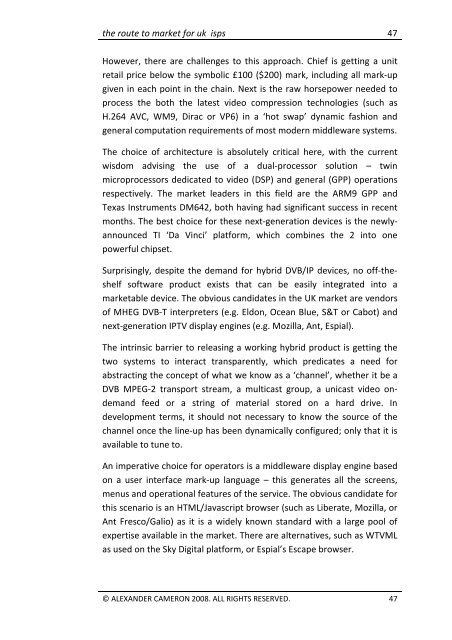Iptv-Vod: The Open 4th Platform - IPTV news
Iptv-Vod: The Open 4th Platform - IPTV news
Iptv-Vod: The Open 4th Platform - IPTV news
You also want an ePaper? Increase the reach of your titles
YUMPU automatically turns print PDFs into web optimized ePapers that Google loves.
the route to market for uk isps 47<br />
However, there are challenges to this approach. Chief is getting a unit<br />
retail price below the symbolic £100 ($200) mark, including all mark-up<br />
given in each point in the chain. Next is the raw horsepower needed to<br />
process the both the latest video compression technologies (such as<br />
H.264 AVC, WM9, Dirac or VP6) in a ‘hot swap’ dynamic fashion and<br />
general computation requirements of most modern middleware systems.<br />
<strong>The</strong> choice of architecture is absolutely critical here, with the current<br />
wisdom advising the use of a dual-processor solution – twin<br />
microprocessors dedicated to video (DSP) and general (GPP) operations<br />
respectively. <strong>The</strong> market leaders in this field are the ARM9 GPP and<br />
Texas Instruments DM642, both having had significant success in recent<br />
months. <strong>The</strong> best choice for these next-generation devices is the newlyannounced<br />
TI ‘Da Vinci’ platform, which combines the 2 into one<br />
powerful chipset.<br />
Surprisingly, despite the demand for hybrid DVB/IP devices, no off-theshelf<br />
software product exists that can be easily integrated into a<br />
marketable device. <strong>The</strong> obvious candidates in the UK market are vendors<br />
of MHEG DVB-T interpreters (e.g. Eldon, Ocean Blue, S&T or Cabot) and<br />
next-generation <strong>IPTV</strong> display engines (e.g. Mozilla, Ant, Espial).<br />
<strong>The</strong> intrinsic barrier to releasing a working hybrid product is getting the<br />
two systems to interact transparently, which predicates a need for<br />
abstracting the concept of what we know as a ‘channel’, whether it be a<br />
DVB MPEG-2 transport stream, a multicast group, a unicast video ondemand<br />
feed or a string of material stored on a hard drive. In<br />
development terms, it should not necessary to know the source of the<br />
channel once the line-up has been dynamically configured; only that it is<br />
available to tune to.<br />
An imperative choice for operators is a middleware display engine based<br />
on a user interface mark-up language – this generates all the screens,<br />
menus and operational features of the service. <strong>The</strong> obvious candidate for<br />
this scenario is an HTML/Javascript browser (such as Liberate, Mozilla, or<br />
Ant Fresco/Galio) as it is a widely known standard with a large pool of<br />
expertise available in the market. <strong>The</strong>re are alternatives, such as WTVML<br />
as used on the Sky Digital platform, or Espial’s Escape browser.<br />
© ALEXANDER CAMERON 2008. ALL RIGHTS RESERVED. 47


